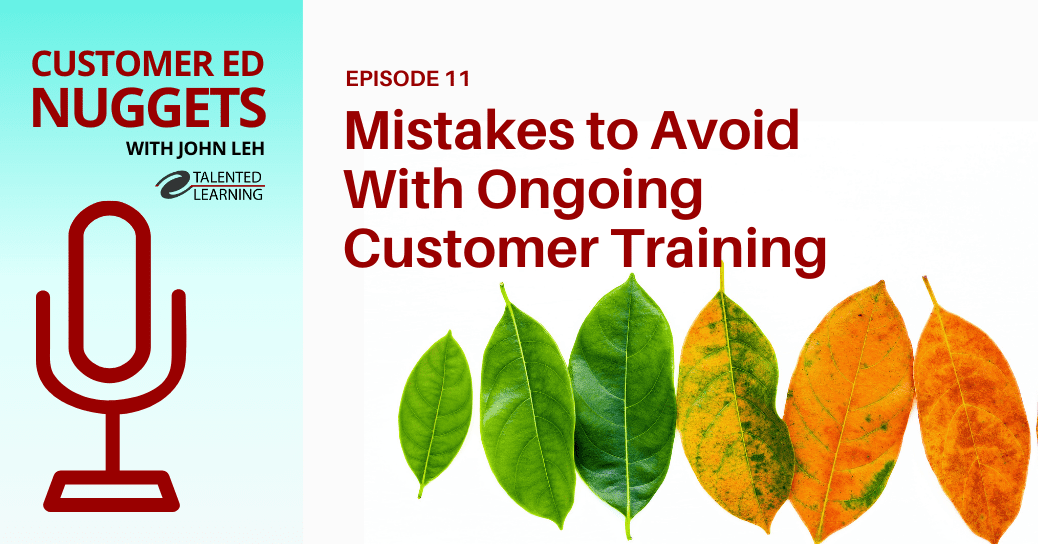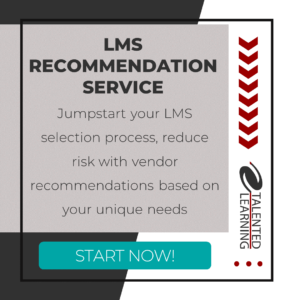
When you see the term “learning strategy” what comes to mind? Some people think of specific instructional design techniques that aim to help people absorb and apply educational content.
That’s fine. But learning strategy can also be defined in a much more expansive way. This is especially true in extended enterprise environments, where training participation is often voluntary, not mandatory.
Learning Strategy In The Extended Enterprise
In these situations, you’re likely to start with very little data about individuals in your target audience. So before anyone chooses to participate, you need to find them, get their attention and persuade them that your learning offer is worth their time and money.
This kind of scenario requires a thoughtful learning strategy that marries instructional design with other highly specialized functions such as:
- User experience and web architecture
- Integrated content strategy, development and management
- Communications and marketing
- Demand generation and ecommerce
- Customer success and customer experience management
- Data management, security and systems integration
- Performance analytics and business insights
These diverse disciplines must work in concert to ensure that your learning program is woven into your organization’s broader ecosystem and workflows. It’s not easy. But a strategic approach helps.
As an independent learning technology consultant, I’ve seen plenty of hits and misses when it comes to learning strategy in the business world. Along the way, I’ve been fortunate to meet an impressive array of strategic thinkers and doers – industry advisors, technology innovators and practitioners, alike.
Over the past few years, I’ve tried to capture some of that lightning in a bottle during podcast interviews on The Talented Learning Show and at our monthly webinars. And last summer, I launched a series of posts, featuring top tips in several categories:
Today, I’m adding to this collection with some of the best advice I’ve heard about learning strategy. I think you’ll find these nuggets useful…
Learning Strategy: Insights From Industry Experts
From Episode 27:
How Can You Create Great Microlearning?
Q: Should organizations think about applying microlearning across-the-board, or focus only on particular applications?
A: Dr. Karl Kapp, best-selling author, consultant and Professor of Instructional Technology at Bloomsburg University.
For any L&D intervention, resources are limited and there’s only so much time available. So you need to think about where microlearning can have the most impact. What’s the biggest need? How can you provide something that people really want?
Organizations like microlearning because it seems faster and they want quick fixes. But you need to think about whether it’s suitable for the intended outcome.
For example, remember Sully Sullenberger – the pilot who landed the US Airways plane on the Hudson River? Sully didn’t know how to do that through a series of microlearning modules.
He had an extensive understanding of how airplanes and gliders work. He was a trainer, so he had thought extensively about how to land in crash scenarios. Plus, he had deep knowledge and hands-on experience as a pilot.
You can do a lot with microlearning. But I wouldn’t want a surgeon who learned only through microlearning. That definitely requires deeper knowledge and skills.
So I think organizations risk a lot when they don’t have at least some folks with rich knowledge about their industry and their functional role, as well as their company and its customers. Microlearning cannot replace that.
From Episode 28:
What Gives Product Training Broader Appeal?
Q: If you could do anything to take your product training up another notch, what would that be?
A: Mike Martin, Head of Customer Experience and Training at SAP Litmos
We want to provide resources that help customers move beyond the basics, so they’re not just getting the best product, but also the best training.
We really want to dig into use-case stuff. So it’s not just about learning how to set-up activity tracking or run reports. It’s about helping them understand what they can do with that information. And sharing daily best practices is different than just writing a how-to manual.
For example, it’s important to help customers learn how to run a report. But it’s also helpful to teach them how to format results data so they can present it to executives who have zero time for details.
The basics are a must-have, but we’re shifting toward also helping customers understand how to get the most value possible from using a feature. It’s also about making everything more relevant to them, rather than just talking in big-picture terms.
So we want to provide a forum where we can openly and honestly discuss what’s going on in their world and focus on specific solutions. It could be a talk show format or a series of online roundtables or podcasts like this. But it’s important to have more of those kinds of conversations, so we can help customers get more out of the product and connect them more deeply with the brand.
From Episode 24:
What Factors Actually Drive High-Impact Learning?
Q: To build skills through high-impact learning that lasts (HILL Model), what should organizations consider?
A: Paul Morton, Former Regional Sales & Revenue Director at CrossKnowledge
Here is the elephant in the room. Gartner says that 80% of CEOs don’t have people in the right place with the right skills to do the jobs of today – much less the jobs of tomorrow.
But data also shows that desired skills haven’t really changed over the years. It’s about empathy, ethics, fairness, being inclusive, working effectively with people and working through stress with grace.
These are core human skills that – along with coaching, mentoring and leadership – make a real difference, every day. You cannot outsource this. And no machine will ever be able to handle it.
We know that when individuals are constantly improving themselves, they will, in turn, improve their organization. You cannot shape, change and redirect an organization without shaping and changing and redirecting the individuals within it. And the HILL method answers the genuine needs of individuals as well as organizations.
We all want to learn how to do our jobs better. It’s as simple as that. We want skills – not just access to information. If information access is the problem, then Google is the answer.
But what people really want is to develop meaningful, relevant skills in a proven way. And this method is proven. We are using it to build-out a universal skills framework that organizations will soon be able to apply.
So I would say get creative. Don’t think about content. Instead, think about improving your learning paths and experiences. Focus on creating a learning experience that you can improve over time.
Adjust your mindset. Prepare to continually readjust according to your learners’ needs. That should get you a lot further than either planning yourself into paralysis or going down the wrong path by delivering something costly and inflexible that’s not fit for purpose.
From Episode 34:
How Can Online Customer Education Help a Business Grow?
Q: You’ve been with Arrowstream for 9 years, so you’ve seen it grow from an idea, to implementation, to measuring results. And now you’re preparing for the next level. What do you wish you knew at the start?
A: Brittany Tamul, Director of Customer Success at ArrowStream
I love that question. If I could go back and share some advice with former Brittany, I would encourage her to think more creatively about how to leverage technology to supplement learning.
I would also tell her not to be afraid, just because she wasn’t doing instructor-led training. Instead, she should feel confident about moving to online training because she will be able to offer customers the same high-quality learning experience through digital technology.
From Episode 20:
Which eLearning Trends Matter to L&D Professionals?
Q: If you were advising someone who’s just starting out as a learning practitioner, what skills would you recommend they develop? And what does it take to future-proof a learning technology career in the 21st century?
A: Donald H. Taylor, Author, Strategic Advisor and Chair at Learning Technologies Conference
That’s a fantastic question. And the answer is…your career is never future-proof. I know this for two reasons:
- Firstly, the organizations that you rely on today may not be here tomorrow.
- Secondly, the technology that you rely on today may not be here tomorrow.
So do not hitch your wagon to any particular organization or technology. I don’t mean be disloyal. I mean be realistic.
And to keep up-to-date throughout your career, a professional network is not just a nice-to-have – it’s absolutely crucial. Nothing is more valuable to protect your future development and expand your future career choices.
Over the years, I’ve learned so much from my network. And all the successful job-hunters I know have tapped into their network when looking for new opportunities.
But the other thing that a network enables you to do – especially via Twitter and LinkedIn – is to tap into some fantastic resources that bubble-up through your interactions. They will challenge your thinking and help you develop yourself.
If you want to be effective and stay ahead professionally, it’s important to remain constantly curious and continue developing your knowledge. So my advice is this: Make it a habit to be social. Remind yourself every week to learn from other people and give back by helping them learn.
Conclusion
Well, there you have it. Sage learning strategy advice from a stellar group of experts! The Talented Learning Show Podcast has been one of my better ideas to learn and share real-world best practices in extended enterprise learning technology. Stay tuned for upcoming installments of this series.
Thanks for reading!
Share This Post
Related Posts
The Future of Customer Education: Customer Ed Nugget 16
Customer education is rapidly evolving as organizations embrace new strategies and tech. What does this mean for the future of customer education? See what experts say on this Customer Ed Nuggets episode
Education Strategy Mistakes to Avoid: Customer Ed Nugget 15
What does it take to deliver a successful customer education program? It starts with a solid education strategy. Learn how to avoid common pitfalls on this Customer Ed Nuggets episode
Which LMS is Best for You? New Shortlisting Tool for 2024
How can you find the best learning system for your business? Our LMS shortlisting tool can help. Learn about the 2024 RightFit Solution Grid. Free, reliable guidance based on our independent research
How to Build a Learning-Based Business: Executive Q&A Notes
Building and selling online courses may seem easy, but building a profitable learning-based business is far more complex. Find out what successful leaders say about running this kind of business
The Rewards of Community Building: Customer Ed Nugget 14
What role does community play in your customer relationships? Find out why community building is such a powerful force in customer education on this Customer Ed Nuggets episode
Benefits of Training Content Syndication: Customer Ed Nugget 13
If you educate customers online, why should you consider content syndication? Discover 10 compelling business benefits in this Customer Ed Nuggets episode
Top Marketing Skills to Master: Customer Ed Nugget 12
Successful customer education programs depend on professionals with expertise in multiple disciplines. Which marketing skills lead to the best results?
How to Measure and Improve Partner Training ROI
An educated channel is a successful channel. But how do you know if your educational programs are effective? Learn from an expert how to evaluate partner training ROI
Mistakes in Ongoing Customer Training: Customer Ed Nugget 11
Customer education doesn't stop with onboarding. It pays to invest in ongoing customer training. Learn which mistakes to avoid in this Customer Ed Nuggets episode














FOLLOW US ON SOCIAL